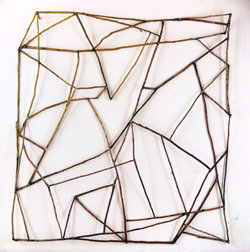Charles Arnoldi
dal 11/1/2008 al 29/3/2008
Segnalato da
Frederick R. Weisman Museum of Art
11/1/2008
Charles Arnoldi
Frederick R. Weisman Museum of Art, Malibu
Featuring over 25 large-scale works in wood from the 1970s and 1980s, this exhibition is the first major museum survey devoted to the artist. His Twig Paintings used a lattice of branches to create a natural linear drawing in space.

This is the first museum retrospective exploring Charles Arnoldi's use of wood as an important creative medium. In the 1970s and 1980s, Arnoldi created wood constructions that cross the boundary between painting and sculpture.
His Twig Paintings used a lattice of branches to create a natural linear drawing in space. In his Chainsaw Paintings he carved into thick sheets of plywood with a chainsaw, turning violent cuts into poetic shapes. Reflecting national trends towards process art as well as a growing awareness of the natural environment, this fascinating body of powerful and lyrical works of art defined his signature style and helped establish the contemporary Los Angeles art scene.
"Charles Arnoldi rose to prominence during the 1970s and 1980s, a period that
corresponds to the growth of Los Angeles as a major center for contemporary art,"
says Michael Zakian, director of the Frederick R. Weisman Museum of Art. "His works
in wood from the period--especially the Stick and Chainsaw paintings--helped define
the L.A. style. I am excited to re-examine this historic body of work and present it
to the public."
Born in 1946 to a blue-collar family in Dayton, OH, Arnoldi came to California soon
after high school. After a short stint in construction, he studied briefly at the
Art Center School of Design and then the Chouinard Art Institute before winning the
Los Angeles County Museum of Art New Talent Award in 1969.
Originally a painter, he began to experiment in the early 1970s with wood. At first
he lashed together thin strips of wood to create open lattice structures. Resembling
Polynesian navigation maps, these primitive constructions hung on the wall as an
alternative to traditional painting.
After noticing the dramatic silhouettes of charred trees left by a local wildfire,
he began to use branches in his art. He admired branches for their "distinct line
quality." "They feel hand-drawn," he said. "They have a certain gestural quality, a
naturalness."
Arnoldi began using them in constructions, stripping them, painting them, and
exploiting their natural curves and lines. These Stick Paintings vary in mood from
the open and lyric to the dense and weighty, and make explicit reference to nature,
an important aspect of life in California. After Mount St. Helens erupted in 1980,
he created a series of "logjams"--dense and aggressive accumulations of branches
that emulate nature's cataclysmic power.
He embarked on another new direction in the early 1980s when he began using a
chainsaw to cut, carve, and "draw" into large sheets of plywood. These Chainsaw
Paintings have lines that are ripped, torn, and appear intensely expressive. They
reflect both the violence inherent in American culture as well as in Arnoldi's own
childhood, growing up as he did in an alcoholic family in the decaying Rust Belt.
This exhibition is accompanied by a catalog with a critical essay that examines
Arnoldi's work not simply as a California phenomenon but also as part of a national
trend in the 1970s towards Postminimalism, a style where artists experimented with
non-art materials in highly subjective and eccentric compositions. It also looks at
his use of wood and techniques of house construction as a comment on America's
waning role as a leading manufacturing nation at the end of the 20th century.
Charles Arnoldi: Wood includes 25 large-scale works from 1970 to 1990. Lenders
to the exhibition include close friends of the artist such as architect Frank Gehry,
actor and artist Dennis Hopper, and Governor Arnold Schwarzenegger, as well as
California collector Dallas Price and the Long Beach Museum of Art.
Charles Arnoldi has been honored with over 100 one-person exhibitions since 1971 and
was included in prestigious group shows such as Documenta 5 and the 1981 Whitney
Biennial. His art is found in over 30 museum collections across the nation,
including the Art Institute of Chicago, Los Angeles County Museum of Art,
Metropolitan Museum of Art, Museum of Modern Art, San Francisco Museum of Modern
Art, and Smithsonian American Art Museum.
This exhibition was curated by Michael Zakian, Ph.D., director of the Frederick R.
Weisman Museum of Art, and will be seen only at Pepperdine University, Malibu, CA.
Works are on view at the Frederick R. Weisman Museum of Art in the Gregg G. Juarez
Gallery, West Gallery, and Ron Wilson-Designer Gallery.
Reception: Saturday, January 12, 6-8pm
Frederick R. Weisman Museum of Art
24255 Pacific Coast Highway, Malibu



